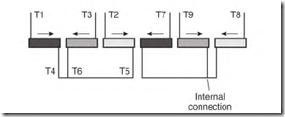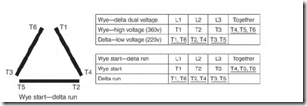If the motor is designed to be constant horsepower (Fig. 5.52c), the lowspeed constant-torque connection will cause it to draw very high amperes. If amperes are high, test the motor (with limited power) using the constanthorsepower connections.
If the motor connection has been positively identified and has very little power, it is connected (or redesigned) for higher voltage than is being applied. Test the motor (first, with limited power) using a higher voltage.
Two-Speed Two-Winding Connection
The two-speed two-winding motor has two sets of three leads that light to each other. The lead numbers are T 1, T2, and T3 for low speed; T 11, T12, and T13 for high speed. There may or may not be two horsepower ratings on its nameplate. If so, the low-speed horsepower will be less than that of the high speed.
The two-speed two-winding motor has the same number of circuits (two sets of three) as the part-winding start motor (to be covered next).
Part-Winding Start Connection
The part-winding start motor will have two circuits of three leads. One circuit is numbered T1, T2, and T3; the other, T7, T8, and T9. Each circuit contains a portion of a single-speed winding.
The most common connection is the half-winding start, using the twowye connection. (One-half of the winding is in each circuit.)
Applying limited three-phase current to one circuit will identify this connection. If the motor starts and runs, do the same test with the other circuit. Both circuits should run at the same speed and amperes. The motor’s power is roughly one-half with one circuit.
The motor may or may not be noisy (depending on the internal pole-topole connection), and the amperes will be low. Connect line 1 to Tl and T7, line 2 to T2 and T8, and line 3 to T3 and T9. The motor should start and run with full power. (The motor starts the load on one-half of its winding. After 2 or 3 seconds, the other half is energized.)
The inrush amperes are one-half the amps of across-the-line starting (using the complete winding). As the speed increases, the amperes in the first-stage winding drop. When the second-stage winding is energized, its ampere demand will be about the same as that of the first stage. With both stages energized, the total ampere demand is less than that of across-the-line start.
Part-winding starting is not recommended for a load that demands frequent or heavy prolonged starts. (Excessive heat will develop in the first-stage winding because it has full voltage applied to it.) If heat doesn’t have time to dissipate (from frequent starts), the winding’s insulation life is reduced. The wye-delta start method (discussed later in this section) is better for heavy prolonged starting.
Part-Winding Start of a Two-Pole Motor
Two pole motors can be part-winding started if they have the right internal connection. If Tl, T2, and T3 are connected to the first pole of each phase, as illustrated in Fig. 5.53, the motor will start and run normally (when T7, T8, and T9 are energized). If T3 is connected to a pole in the other half of the winding, the motor may reverse itself when the second half is energized.
Concentric-Style Winding and Part-Winding Start Connection
The nine-lead motor (with a concentric-style winding) won’t start on part of its winding. This problem occurs often when a lap wound motor, or a specially connected part-winding start motor, is replaced with a standard (concentric-wound) motor. A special connection (not used on standard ninelead dual-voltage motors) has to be used.
FIGURE 5.53 The internal connections for a two-pole motor that will work with a part-winding start control. The motor won’t reverse when the second half is energized.
To keep up with competition and high-volume demand, most motor manufacturers use the concentric winding method. Concentric-shaped coils can be inserted into a motor’s slots with a machine. (The lap winding has to be wound by hand.) Electric motor repair centers often redesign the concentric winding to lap winding.
Wye-Delta Connection
The wye-delta connection (Fig. 5.54) is used in Europe as a dual-voltage connection. In the United States, the connection is used primarily as a starting method.
A motor connected wye-delta will have three sets of two leads that light to each other (Tl to T4, T2 to T5, and T3 to T6). There will be two voltage ratings on the nameplate, with the higher voltage (wye) being 1.73 (the square root of 3) times the lower voltage (delta).
The operating voltage (for wye-delta starting) is that of the delta connection. If the delta connection is rated 220 volts, the wye connection voltage will be 380 volts (a difference of 160 volts). To produce full power, the volts per turn must be the same for both connections.
Verify the connection by connecting T4, T5, and T6 together; then apply limited three-phase current to T 1, T2, and T3. (Use the voltage rated for the delta connection.) The motor should start slowly and have reduced power. Reconnect the motor (using the delta connection: line 1 connected to Tl and T6, line 2 to T2 and T4, line 3 to T3 and T5). If the voltage and connection are correct, the motor should run normally with full load.
Wye-Start, Delta-Run Starting Method
The wye-start, delta-run method of starting is similar to reduced-voltage starting. The wye connection is energized first with 220 volts (the delta
FIGURE 5.54 The wye-delta connection.
operating voltage). A few seconds later the control switches to the delta connection, and the motor runs at full power.
Using this method, the inrush amperes are much less than with acrossthe-line starting. This allows the motor to take more time to start a heavy load, without excessively overheating its winding.
The motor will have approximately one-third of its normal torque on the wye connection. The load must not require a breakaway torque higher than the wye connection can produce.
If a wye-delta-connected motor doesn’t have enough breakaway torque, the one-delta start, two-wye run connection can be used. (The operating voltage must be for two wye.) The one-delta start, two-wye run connection (explained a bit later under “Thyelve-Lead Single-Speed Motors”) produces 40 percent more starting torque than the wye-delta method. Inrush amperes are higher than those of the wye-start, delta-run method.
Wye-Delta Induction Motor with Unknown Voltage
Sometimes a motor’s nameplate is missing or doesn’t show a voltage rating. If the coils are mush-wound lap or concentric, the motor’s voltage may be rated anywhere from 208 to 760 volts (Fig. 5.55). (The mush winding is rarely used on voltage above 760 volts.) The coil wire is usually visible with the mush winding.
Form-wound coils are used in motors above 2400 volts. This type of winding is rarely found in motors rated 760 volts and less. The coils are each wrapped with insulation. A motor repair center or the motor’s manufacturer should be consulted to determine the correct voltage.
Applying a voltage that is too high (for example, 460 volts to a 230-volt motor) will destroy a motor in a few seconds. Always use limited current (resistors) when the voltage is unknown.
When the voltage is uncertain and the motor has no electrical problems, the following procedures should be followed:
1. Connect it wye and run it without a load, with limited current.
2. If the motor starts slowly and draws very few amperes, then the voltage is too low or the delta connection should be used.
3. Connect the motor delta and apply the same voltage (using limited current). The motor will start more quickly and draw more amperes than with the wye connection.
Apply full voltage while watching the way it starts, and the no-load
FIGURE 5.55 Tivo shapes (concentric and lap) used in mush-wound motor windings.
1. If it starts slowly and amperes are low, apply the next-higher voltage, using the same procedure (wye connection first), until the motor starts and runs normally.
2. Load the motor and check the amperes.
3. Assuming the amperes aren’t excessively high, use a tachometer to see if the RPM is satisfactory. (Motors above 50 horsepower will have less slip than motors under 50 horsepower.) Divide 7200 by the number of poles to get the motor’s synchronous speed (explained in Chapter 3 under “Revolutions per Minute, Poles, and Hertz”). Slip should be less than 1 percent unless the motor is designed for high slip (5 percent slip is maximum for high-slip motors).
4. If slip is excessive with the wye connection, connect the motor delta and run it with limited current and no load.
5. If amperes aren’t excessively high, apply full voltage and full load and check the RPM. A motor-connected wye using the delta voltage will
start and run almost normally. With the motor fully loaded, however, the slip will be excessive, the windings will overheat, and the motor will fail in a few hours.


